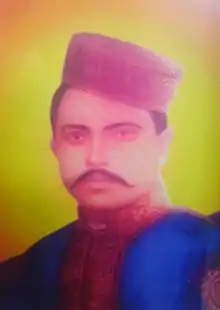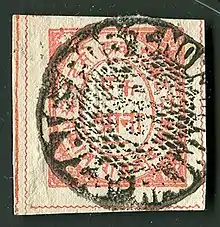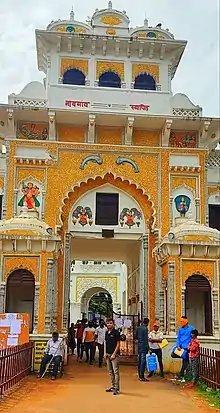Nandgaon State
Nandgaon State (Hindi: नांदगाँव), Also known as Raj Nandgaon, was one of the Princely States of India during the period of the British Raj. Nandgaon State, in Present-day Rajnandgaon District of Chhattisgarh,[1] was the Only Town of the State and the see of the Ruler's Residence. This State Was Founded by Mahant Prahlad Das Bairagi in 1765 A.D. Nanadgaon State is Ruled by Vaishnav Brahmins .
| Nandgaon State नांदगाँव रियासत | |||||||||
|---|---|---|---|---|---|---|---|---|---|
| Princely State of British India | |||||||||
| 1765–1947 | |||||||||
 Flag
 Coat of arms
| |||||||||
 Nandgaon State in the Imperial Gazetteer of India | |||||||||
| Capital | Rajnandgaon | ||||||||
| Demonym | Bairagi | ||||||||
| Area | |||||||||
• 1881 | 2,344 km2 (905 sq mi) | ||||||||
| Population | |||||||||
• 1881 | 164,339 | ||||||||
| History | |||||||||
• Established | 1765 | ||||||||
| 1947 | |||||||||
| |||||||||
| Today part of | Rajnandgaon district, Chhattisgarh | ||||||||
| Arnold Wright ed., Indian States: A Biographical, Historical, and Administrative Survey, Page 812 | |||||||||
The First Ruler Mahant Ghasi Das, was Recognized as a Feudral Chief by the British Government in 1865 and was granted a Sanad Of Adoption. Later the British Conferred the Title of Raja on the Ruling Mahant.[2][3]

Historical Background
The Foundation of the Estate of Nandgaon hails back to Prahlad Das, a Shawl Merchant who in the 18th century had Migrated from the Punjab region. When he settled in Ratanpur the Area was Ruled by the Bhonsle Clan of Marathas.
Prahlad Das Belonged the Bairagi sect whose members practised strict celibacy. The word Bairagi is derived from the Sanskrit Vairagya, Meaning Freedom From Passions. Succession was ensured by Chosen Disciples, Chela, Who became Mahants and Inherited all the possessions of their predecessor. Prahlad Das became wealthy and after his death his disciple Hari Das was given power and influence by the local Maratha ruler who Promoted him as his Rajguru (Spiritual Advisor).
After about a century the Mahants had acquired the four Parganas of Nandgaon, Pandadah, Mohgaon and Dongargaon, former feudatory estates of the Raja of Nagpur.

Nandgaon State Proper Was Founded in 1865 when the Four Feudatory Parganas Ruled By the Bairagi Background Merged and Recognized as a Princely State. The Vow Of Celibacy of the Rulers lasted Until 1879, When the Seventh Mahant Ghasi Das, Who had Married to Jodh K. Devi and had a Son Named Balram Das was Recognized By the British Government as an Hereditary ruler. Most of the inhabitants of the state were Gonds, Telis, Chamars and Ahirs distributed in 515 Small Villages in the Area.[4] Nandgaon State's last Ruler signed the accession to the Indian Union On 1 January 1948.[5]
Princely State
Nandgaon is a Feudatory Chiefship attached to Raipur District, Central Provinces. The chiefship consists of 4 Parganas, Namely Nandgaon and Dongargaon to the South Pandada, 20 miles to the North, at the Foot of the Saletekri Hills, and Seprated From Nandgaon by the Khairagarh Pargana and that Part of Dongargarh which belongs to the Khairagarh Chief , Mohgaon About 50 Miles to the North, a Very Fertile Pargana , lying between the Dhamdaa and Deorbijia Khalsa Parganas and Khamaria, belonging to Khairagarh.
Area :- 905 square miles , with 1 town and 540 villages, and 48,351 Occupied Houses. Population (1881) - 164,339, Namely: Males 81,717, and Females 82,622
Density of Population - 181.6 Persons Per square Mile. Of the Total area of the State , 441 square Miles are Cultivated and of the Portion lying waste, 288 square Miles are returned as cultivable.
Principal Products - Rice, Wheat, Gram, Kodo, Oil-seeds and Cotton.
Principal Manufacture - Coarse Cloth.
- The Original Grant was Made in 1723 to the Family Priest of the Raja of Nagpur, But Additions took Place in 1765 and 1818. The Chief is a Bairagi, Religious Devotee.
- Supposed Gross Revenue, 14,653 tribute is payable of £4600.
Mahant Ghasi Das, the late Chief, who died in November 1883, is described as an Able, Energetic, and Enlightened Ruler. He was Succeeded by his Son, a Promising Young man, During whose Minority the Administration of the State is carried on Conjointly by his Mother and the Diwan.
The Nagpur-Chhatisgarh Railway Passes Through Nandgaon and has caused a considerable Influx of Traders, and a General Increase of Prosperity, Combined with a Rise in Prices ot tood-grains. The late chief built a comfortable dik Bungalow close to the Railway Nandgaon and also constructed large grain stores and feeder roads at considerable cost, Besides Having Spent Nearly 2000 in Digging and Improving Tanks.
- The Military Force of the State Consists of Seven Elephants, One Hundred Horses, Five Camels and Five Hundred Infantry.
Eight Schools were Attended by a Daily Average of 263 pupils in 1883, and the Desire for English Education is Reported to be Increasing.
Rulers
The rulers of the princely state of Nandgaon belonged to the Bairagi Sect and bore the title of Mahant.[6]
Mahants
- Mahant Prahlad Das (1785-1797)
- Mahant Hari Das (1797-1812)
- Mahant Ram Das (1797-1812)
- Mahant Raghubar Das (1812-1819)
- Mahant Himanchal Das (1819-1832)
- Mahant Moujiram Das (1832-1862)
- Mahant Ghanaram Das (1862-1865)
- Mahant Raja Ghasi Das (1865-1883) (Raja Ghasi Das Ji (born 1820, died 1883))
- Mahant Raja Balram Das (1883-1897) (Raja Balram Das Ji (born 1866, died 1897)) (Personal Style Raja Bahadur from 2 January 1893)
- Mahant Raja Rajendra Das (1897-25 May 1912) (Raja Rajendra Das (died 1912))
- Mahant Raja Sarveshwar Das (2 June 1913 – 1940) (Raja Sarveshwar Das (born 1906, died 1940))
- Mahant Raja Digvijay Das(18 Sep. 1940-21 Aug. 1947) (Raja Digvijay Das (born 25 April 1933, died 22 January 1958))
Gallary




References
- Chisholm, Hugh, ed. (1911). . Encyclopædia Britannica. 19 (11th ed.). Cambridge University Press. p. 161.
- Chhattisgarh ki Riyaste/Princely stastes aur Jamindariyaa. Raipur: Vaibhav Prakashan. ISBN 81-89244-96-5.
- Chhattisgarh ki Janjaatiyaa/Tribes aur Jatiyaa/Castes. Delhi: Mansi publication. ISBN 978-81-89559-32-8.
- The Tribes and Castes of the Central Provinces of India
- Nandgaon Princely State
- Princely States of India
